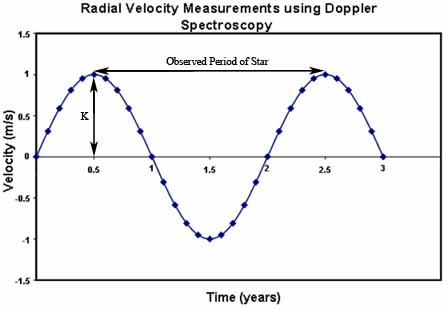Finding Extrasolar
Planets
There are many methods of detecting extrasolar planets currently
available.
The most successful method is doppler spectroscopy. The laws of gravity
make it clear that all masses pull on all
other masses at a rate inversely proportional to their distance.
Because of this, all planets affect the motion of their
stars, with the most massive ones pulling the most strongly. This can
be observed simply with telescopes focused
on any given star, looking for it to move back and forth slightly over
a period of time.
This method has two flaws. Firstly, the most easily detectable planets
are, unfortunately, either very massive or
very close to their star (or both). Because humanity lives on a small
planet at a safe distance from our sun, these
planets are only curiosities. Second, a class of object between planet and star exists, and
these are also invisible
except for gravity. Though these masses (called brown dwarves) are also
scientifically interesting, they are not the
planets we're looking for.
The next most popular method is the transit method. If a planet passes
between us and the star, the apparent
luminosity of the star will decrease. This method has many flaws,
however. The major problem is that many planets
will not pass between us and their star. Another is that other things
can cause the apparent decrease in brightness.
While the transit method has detected planets, doppler spectroscopy has
often been used to verify said planets.
Finally, detecting protoplanetary discs can be of great help. This of
course only works with young star systems, 
and we are still dependent upon the angle, but if one is found, the
light of the star at the center can be blocked out
and the tracks that possible planets move through can be detected. The
image on the main page of this website
shows just such a disc. Other forms of direct detection have been used,
but this is a very inefficient method.
Theoretical methods have also been proposed, but none have been
successful at this time.

